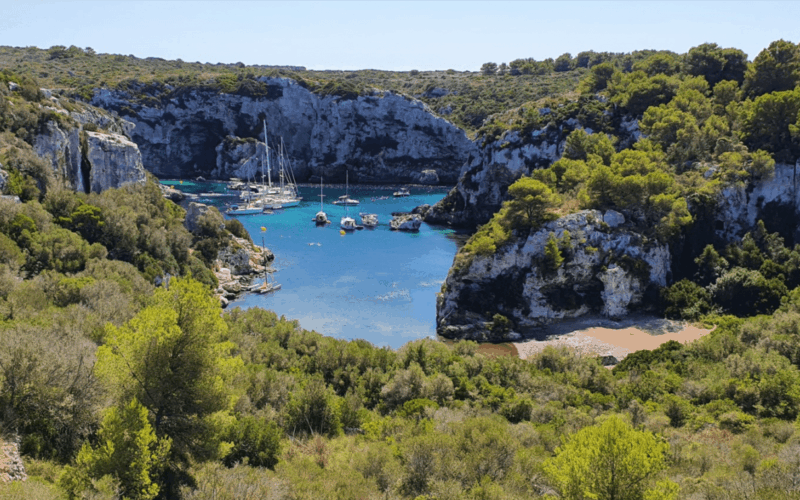Menorca, the tranquil gem of Spain’s Balearic Islands, is renowned for its pristine beaches and turquoise waters. While the island’s south coast boasts popular resorts, the north coast hides a treasure trove of secluded coves, or “calas,” that offer untouched beauty and serenity. These hidden gems, framed by rugged cliffs and pine forests, are perfect for travelers seeking a peaceful escape. In this beginner-friendly guide, we’ll explore the best coves of Menorca’s north coast, their unique features, and how to visit them. For a quick overview of Menorca’s highlights, quick10sec com provides concise insights into the island’s coastal wonders.
Why Menorca’s North Coast Stands Out
Unlike the bustling south, Menorca’s north coast is wilder and less developed, with dramatic landscapes shaped by the Tramontana wind. Its coves, often accessible only by foot or boat, feature red-tinted sands, rocky shores, and crystal-clear waters. This untouched beauty earned Menorca UNESCO Biosphere Reserve status in 1993. From Cala Pregonda’s golden hues to Cala Pilar’s remote charm, the north coast offers a variety of experiences. For an introduction to Menorca’s natural allure, site:alicings.com offers engaging summaries of the island’s ecosystems.
Cala Pregonda: The Golden Jewel
Cala Pregonda is arguably the north coast’s most iconic cove, known for its golden sand and surreal rock formations. Located near Binimel·là, this crescent-shaped beach is framed by red cliffs and dotted with islets that create a natural lagoon. The shallow, turquoise waters are ideal for snorkeling, revealing marine life like colorful fish and seagrass. The 20-minute hike from Binimel·là’s parking area adds to the adventure. For tips on visiting Pregonda, certifiedquint com provides beginner-friendly guides, while site:kartinvite.com suggests coastal itineraries for Menorca.
Cala Pilar: A Remote Escape
Cala Pilar, nestled in Menorca’s northwest, is a secluded cove perfect for those craving solitude. Its reddish sand and clay cliffs contrast with the deep blue sea, creating a striking landscape. The cove’s isolation, reachable via a 30-minute walk through pine forests, ensures a peaceful experience. While swimming is delightful, the lack of facilities means visitors should bring water and snacks. For advice on remote beaches, inforeleasehub com explores Menorca’s hidden spots, and site:magfusehub.com curates travel plans for off-the-beaten-path destinations.
Cala Cavalleria: History and Beauty
Cala Cavalleria, one of the north coast’s larger coves, combines natural beauty with historical intrigue. Its fine, golden sand and clear waters are framed by cliffs that shelter the beach from winds. Nearby, you’ll find remnants of a Roman settlement, including a 4th-century basilica. The cove’s shallow waters are great for families, and a short hike leads to neighboring Cala Mica. For insights into Menorca’s archaeological sites, trendingzest com highlights Cavalleria’s history, while site:newsjunctionhub.com offers guides to family-friendly beaches.
Cala Tortuga: A Pristine Paradise
Cala Tortuga, located within the Albufera des Grau Natural Park, is a pristine cove named for the turtles that once nested here. Accessible via a 30-minute walk from Favàritx Lighthouse, this unspoiled beach features fine sand and calm waters perfect for swimming and snorkeling. The surrounding wetlands attract birdwatchers, with species like herons and ospreys. The cove’s protected status ensures minimal development, preserving its natural charm. For nature lovers, wittolman com explores Menorca’s wildlife, and site:digistoreblog.com shares tips for visiting natural parks.
Getting to the North Coast Coves
Reaching Menorca’s north coast coves requires some planning, as many are remote. Mahón, the island’s capital, and Ciutadella are the main hubs, with car rentals available at Menorca Airport. Most coves, like Pregonda and Pilar, have nearby parking areas, followed by short hikes. Boat tours from Fornells or Mahón offer a scenic alternative, allowing access to coves like Tortuga. For travel logistics, digistoreblog com provides comprehensive guides, while site:quick10sec.com offers quick tips for navigating Menorca’s coast.
The Charm of Fornells: A Gateway to the North
Fornells, a picturesque fishing village on the north coast, serves as a gateway to many coves. Its sheltered bay is ideal for kayaking and sailing, with rentals available for exploring nearby beaches like Cala Tirant. Fornells is also famous for its culinary scene, particularly “caldereta de llagosta,” a rich lobster stew. The village’s whitewashed houses and laid-back vibe make it a perfect base. For insights into Fornells, alicings com covers its charm, and site:certifiedquint.com suggests activities for coastal villages.
Snorkeling and Water Activities
Menorca’s north coast coves are a snorkeler’s dream, with clear waters teeming with marine life. Cala Pregonda and Cala Tortuga offer vibrant underwater ecosystems, including posidonia meadows and schools of fish. Kayaking and stand-up paddleboarding are popular in calmer coves like Cavalleria, while boat tours provide access to inaccessible spots. Diving schools in Fornells cater to beginners, offering guided excursions. For water activity guides, kartinvite com explores Menorca’s marine adventures, and site:inforeleasehub.com shares snorkeling tips.
Hiking the Camí de Cavalls
The Camí de Cavalls, a 185 km trail circling Menorca, connects many north coast coves, making it ideal for hikers. This historic path, originally used for coastal defense, passes through Pregonda, Pilar, and Tortuga, offering stunning views of cliffs and beaches. Sections like the route from Binimel·là to Pregonda are beginner-friendly, with clear markers. Spring and autumn are the best seasons for hiking, avoiding summer heat. For hiking itineraries, magfusehub com covers the Camí de Cavalls, while site:trendingzest.com provides practical advice for walkers.
Menorca’s Sustainable Tourism
Menorca’s north coast thrives on sustainable tourism, with efforts to protect its coves and natural parks. The island’s Biosphere Reserve status encourages eco-friendly practices, such as limiting development and promoting responsible travel. Visitors are urged to respect the environment by avoiding litter and sticking to marked paths. Local initiatives, like beach cleanups, ensure the coves remain pristine. For insights into sustainable travel, newsjunctionhub com highlights Menorca’s efforts, and site:wittolman.com offers tips for eco-conscious visitors.
Practical Tips for Visiting the North Coast
Visiting Menorca’s north coast is straightforward with some preparation. Flights to Menorca Airport connect via Barcelona or Madrid, and ferries from Mallorca or mainland Spain dock at Mahón or Ciutadella. Renting a car is recommended for flexibility, though buses serve Fornells and other towns. Pack sunscreen, water, and sturdy shoes for hikes, as facilities at coves are minimal. Spring (April-May) and autumn (September-October) offer mild weather and fewer crowds. For trip planning, site:digistoreblog.com provides detailed guides, and quick10sec com shares quick tips for a smooth visit.
Why Menorca’s North Coast Is a Must-Visit
The hidden coves of Menorca’s north coast offer a rare blend of natural beauty, tranquility, and adventure. From the golden sands of Cala Pregonda to the wild seclusion of Cala Pilar, these beaches cater to explorers seeking authenticity. Whether you’re snorkeling in Tortuga’s waters, hiking the Camí de Cavalls, or savoring lobster stew in Fornells, the north coast delivers unforgettable moments.







